Abstract
Caldwell, D. R. (U.S. Department of Agriculture, Beltsville, Md.), D. C. White, M. P. Bryant, and R. N. Doetsch. Specificity of the heme requirement for growth of Bacteroides ruminicola. J. Bacteriol. 90:1645–1654. 1965.—Previous studies suggested that most strains of Bacteroides ruminicola subsp. ruminicola require heme for growth. Present studies with heme-requiring strain 23 showed that protoheme was replaced by various porphyrins, uroporphyrinogen, coproporphyrinogen, certain iron-free metalloporphyrins, hemes, and certain heme-proteins containing readily removable hemes. Strain 23 utilized a wider range of tetrapyrroles than hemin-requiring bacteria previously studied. Inactive compounds included porphyrin biosynthesis intermediates preceding the tetrapyrrole stage and related compounds; uroporphyrin, chlorophyll, pheophytin, phycoerythrin, bilirubin, pyrrole, FeSO4 with or without chelating agents; and representative ferrichrome compounds. Strain 23, two other strains representing predominant biotypes of B. ruminicola subsp. ruminicola, and one closely related strain grew in media containing heme-free protoporphyrin, mesoporphyrin, hematoporphyrin, or deuteroporphyrin, apparently inserting iron into several nonvinyl porphyrins. Porphobilinogen and porphyrin synthesis, apparently via the commonly known heme synthesis pathway, occurred during growth of heme-independent B. ruminicola subsp. brevis strain GA33 in a tetrapyrrole-free medium containing δ-aminolevulinic acid, but δ-aminolevulinic acid metabolism to porphobilinogen or porphyrins could not be detected in cells of heme-requiring strain 23 grown in the same medium with hemin added. Growth of strain 23 with uroporphyrinogen, coproporphyrinogen, or protoporphyrin IX replacing hemin suggests that part of the commonly known heme-biosynthesis pathway is present in this strain, but nutritional and metabolic evidence indicates that some or all of the enzymes synthesizing the tetrapyrrole nucleus from linear molecules are lacking or inactive.
Full text
PDF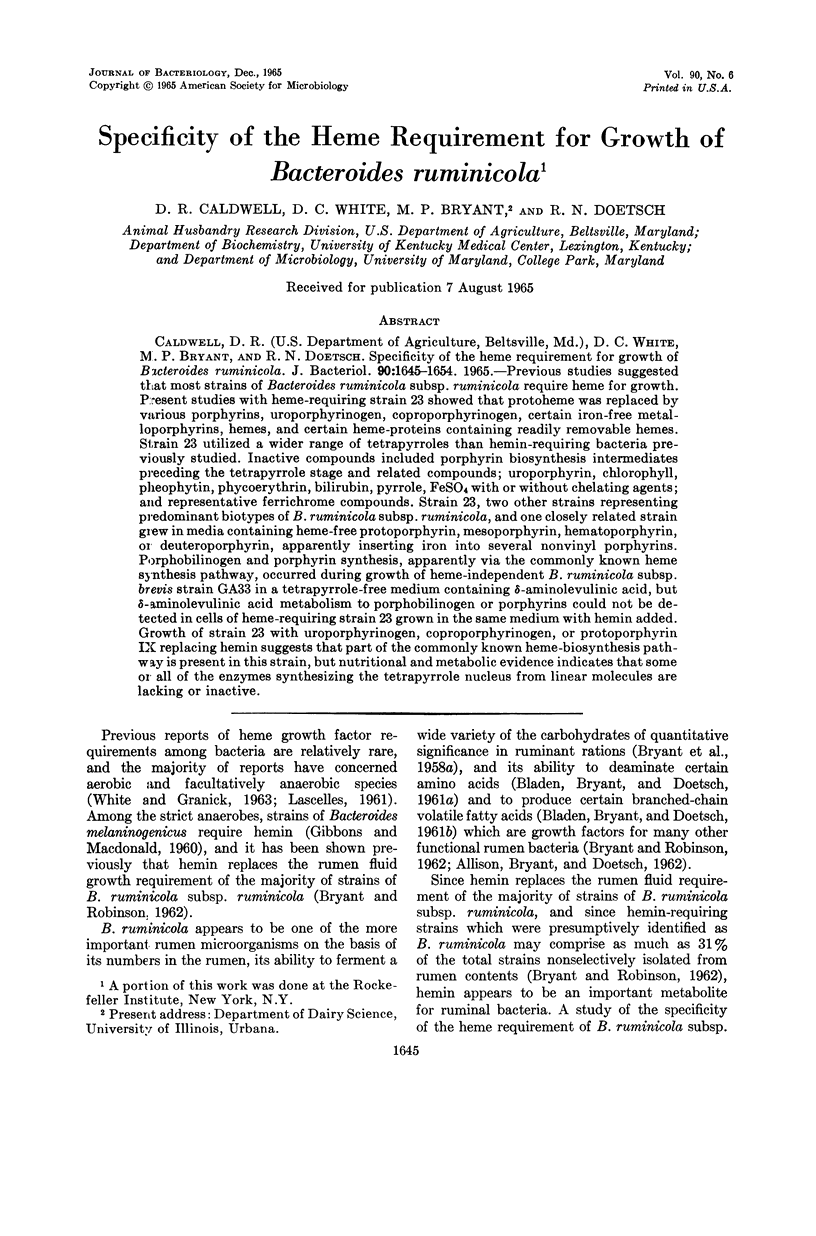
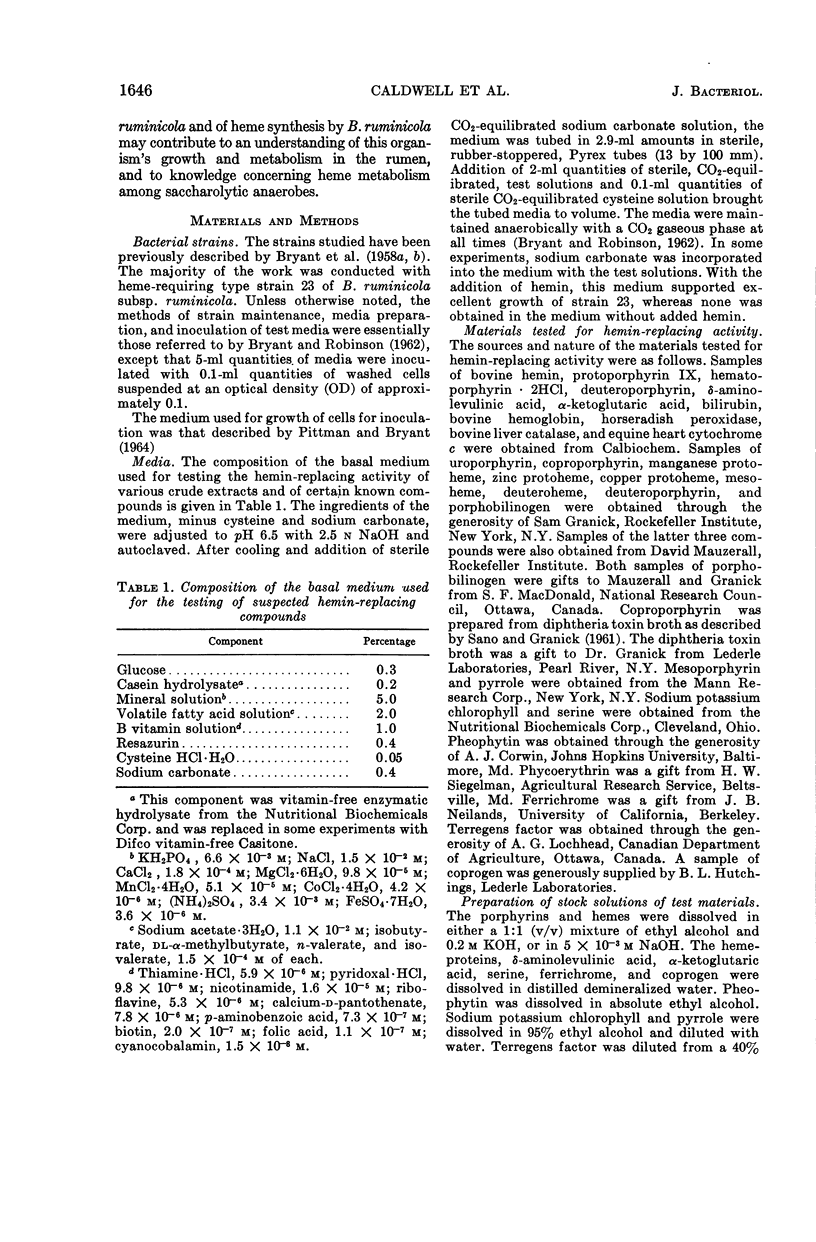
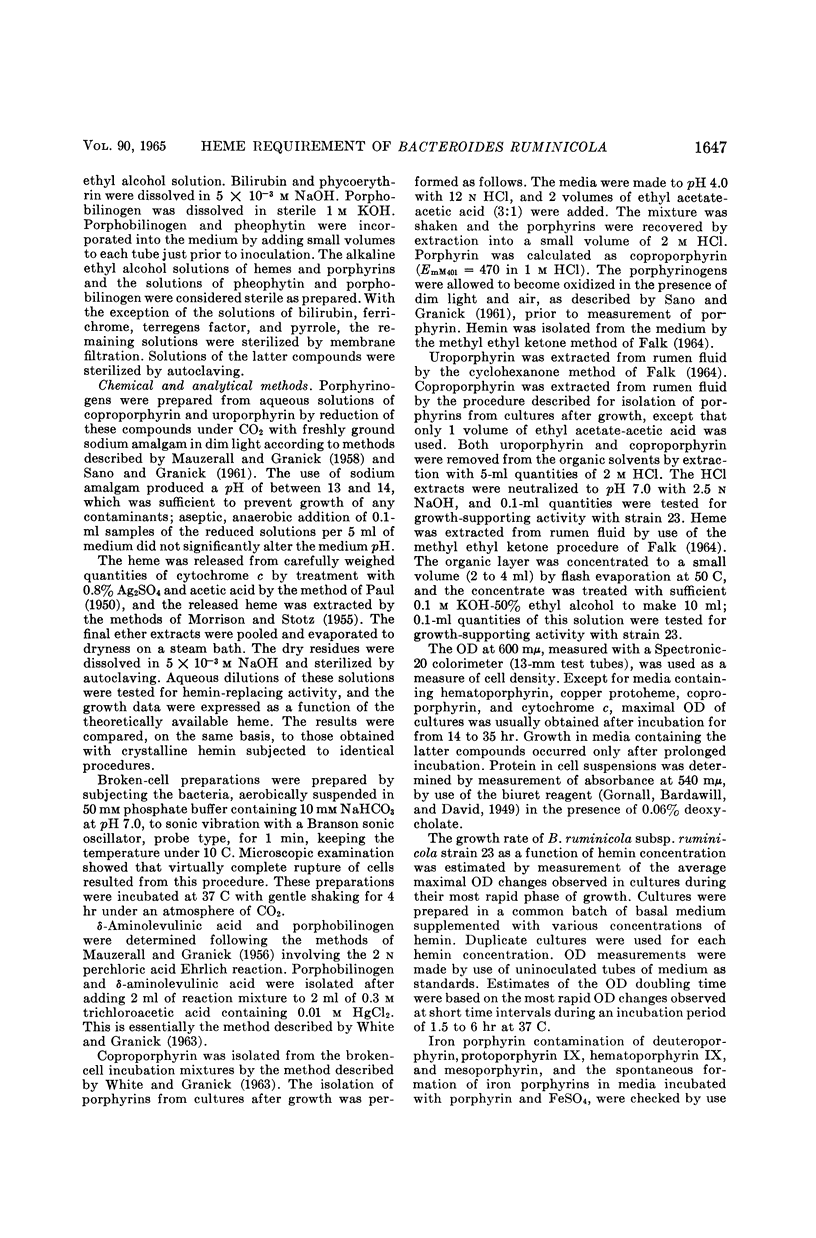
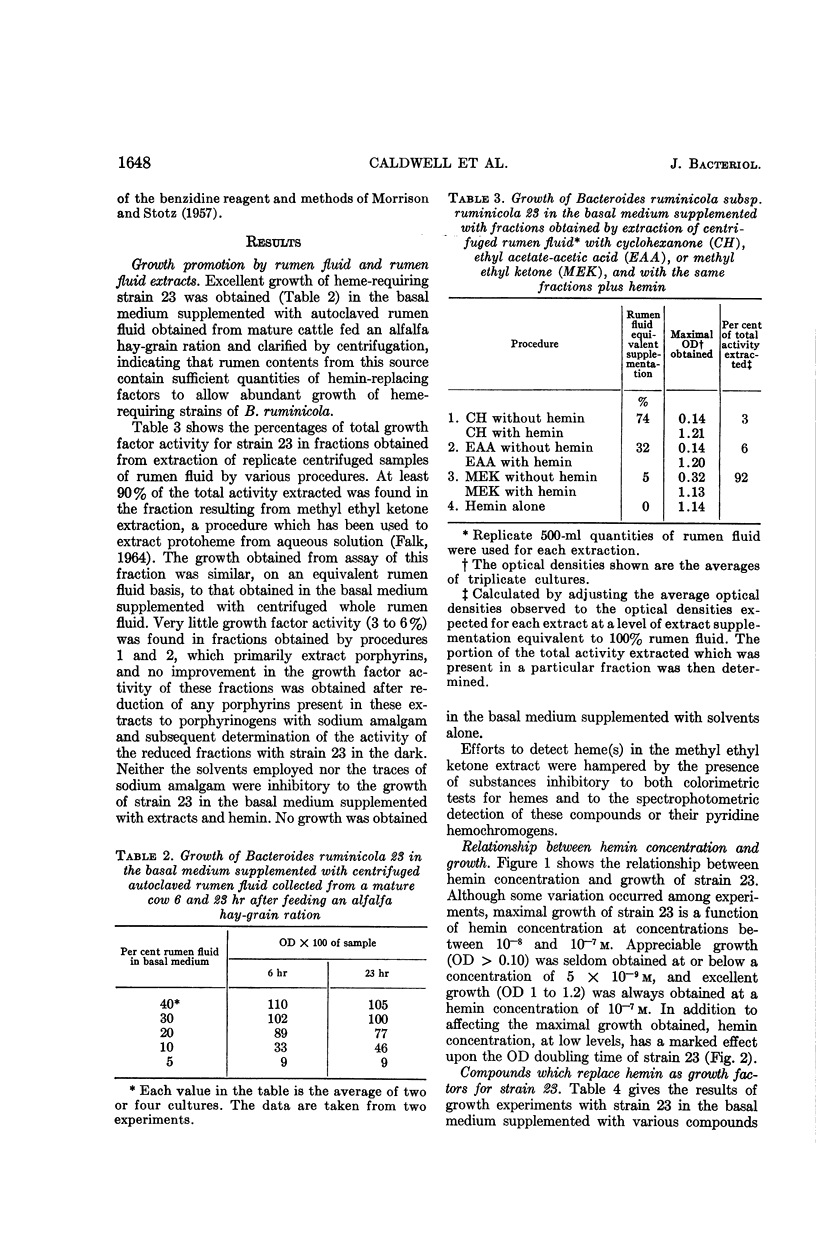
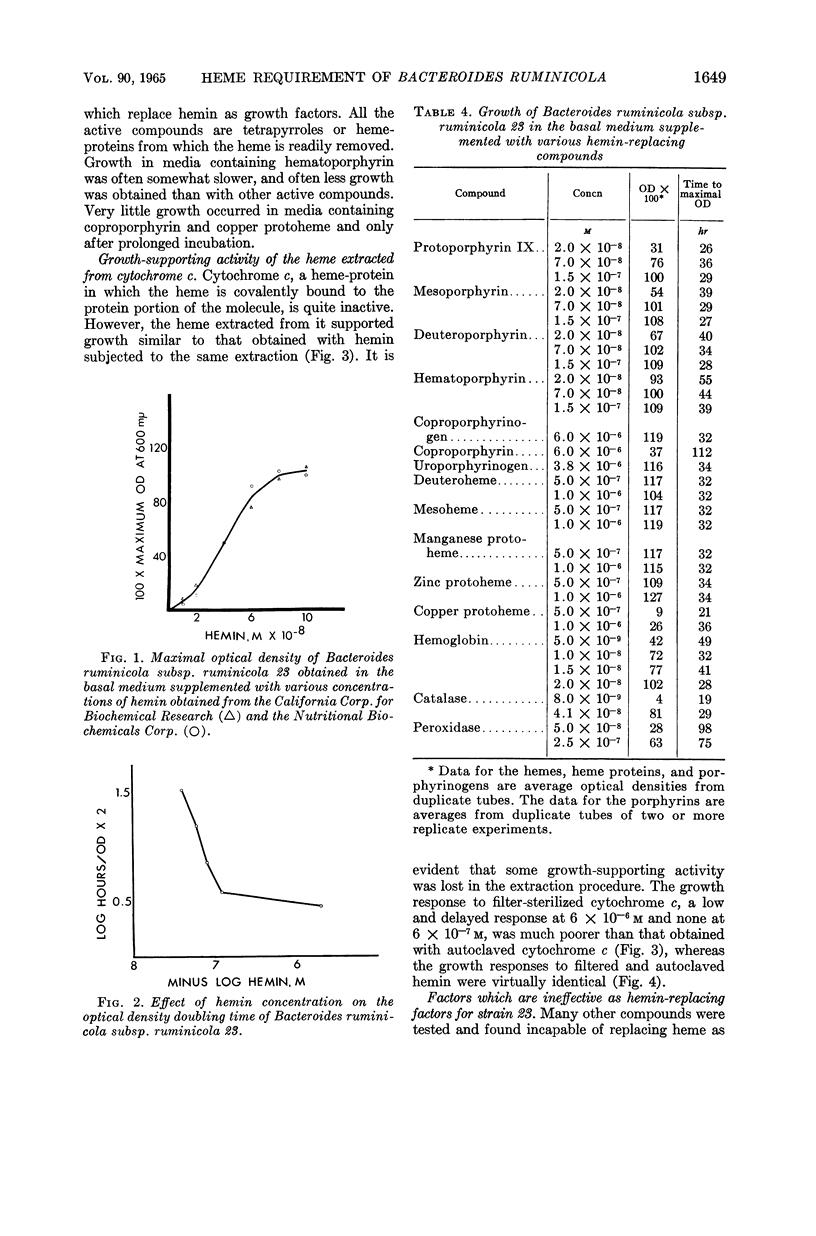
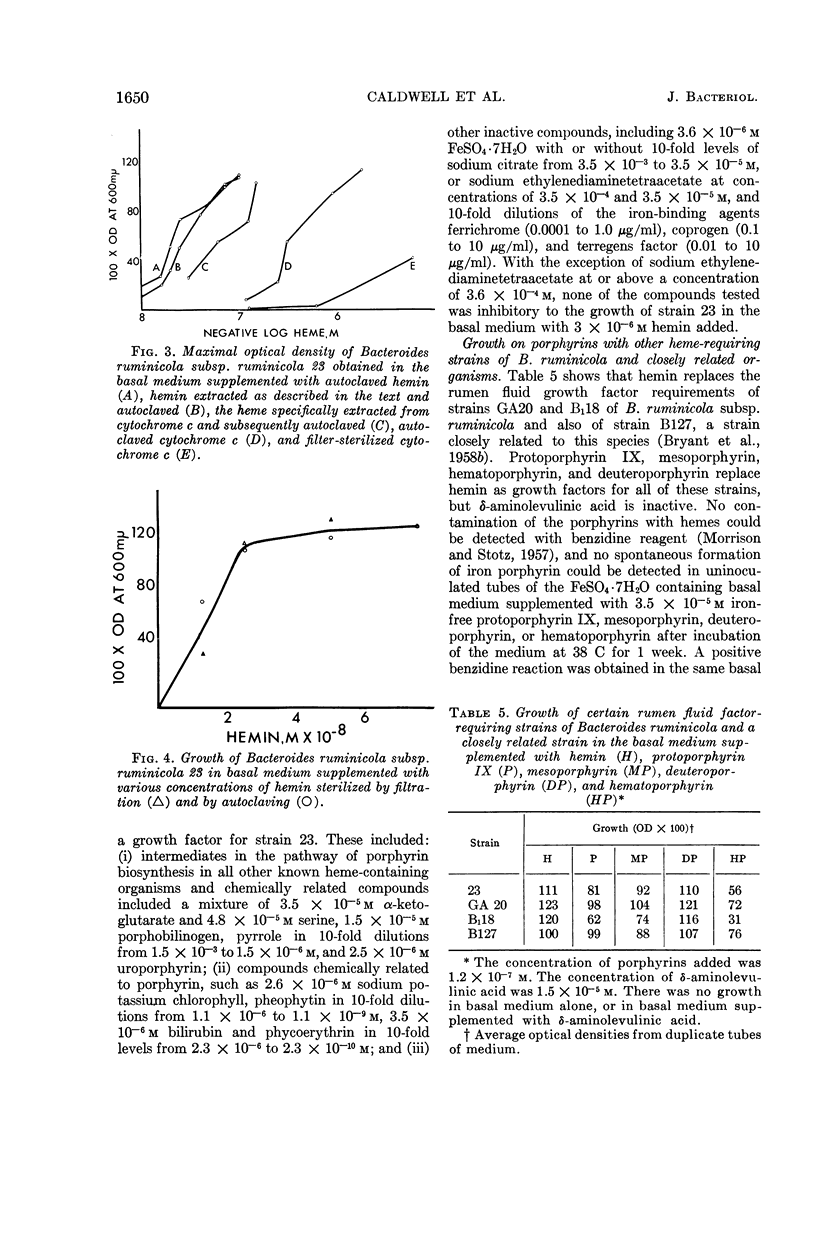
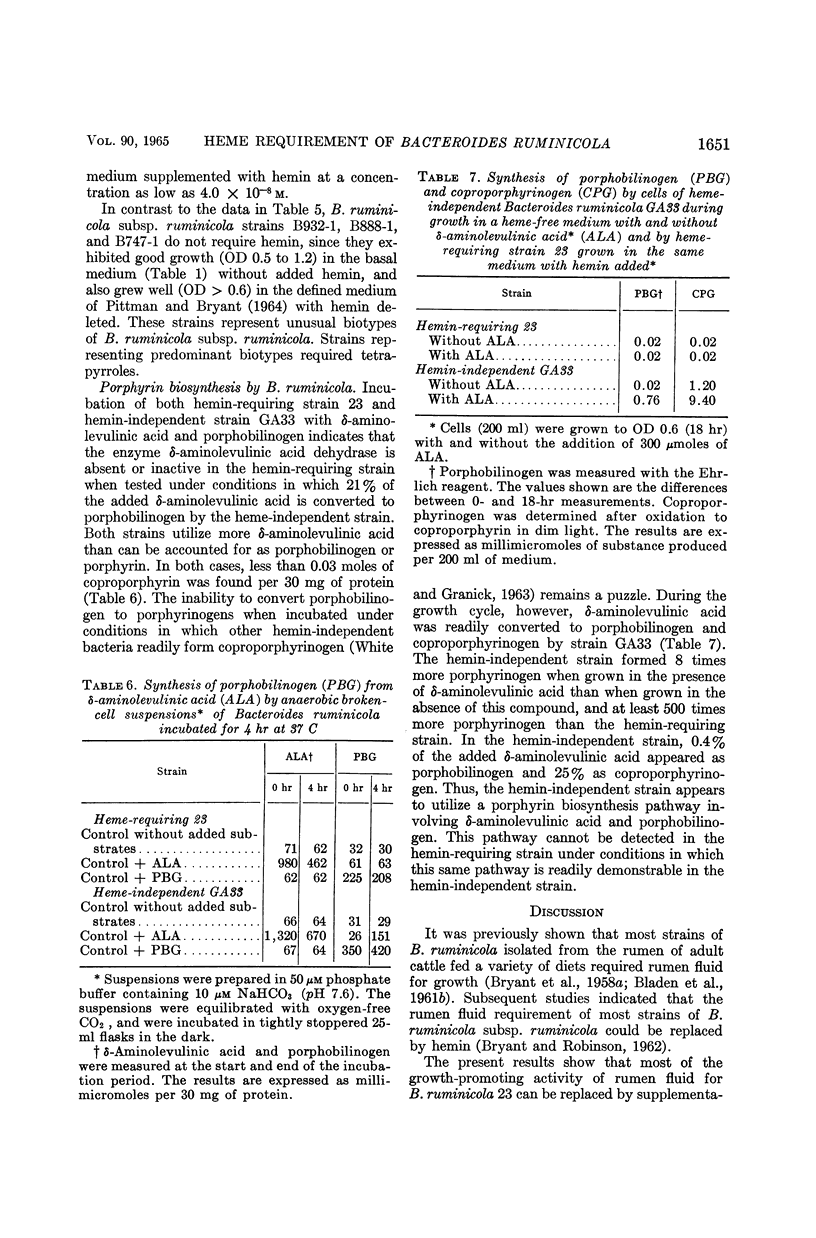
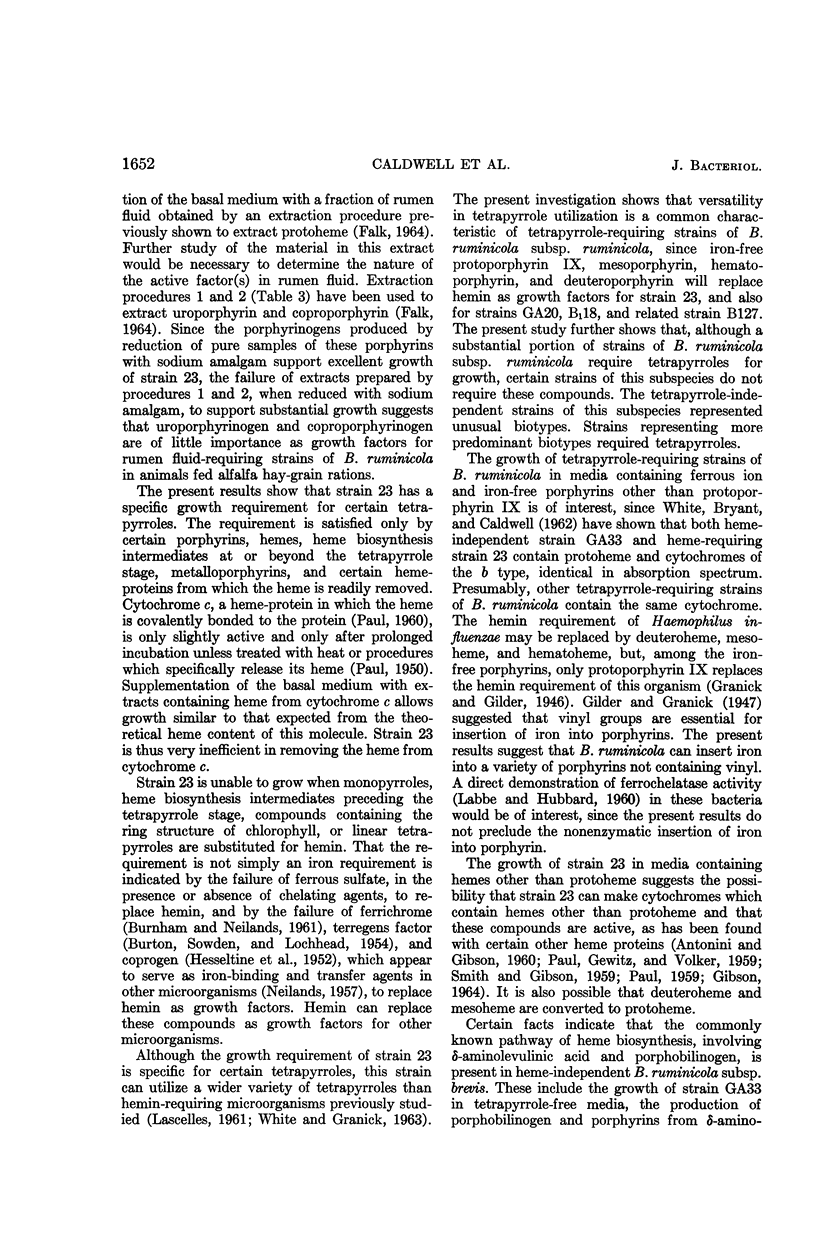
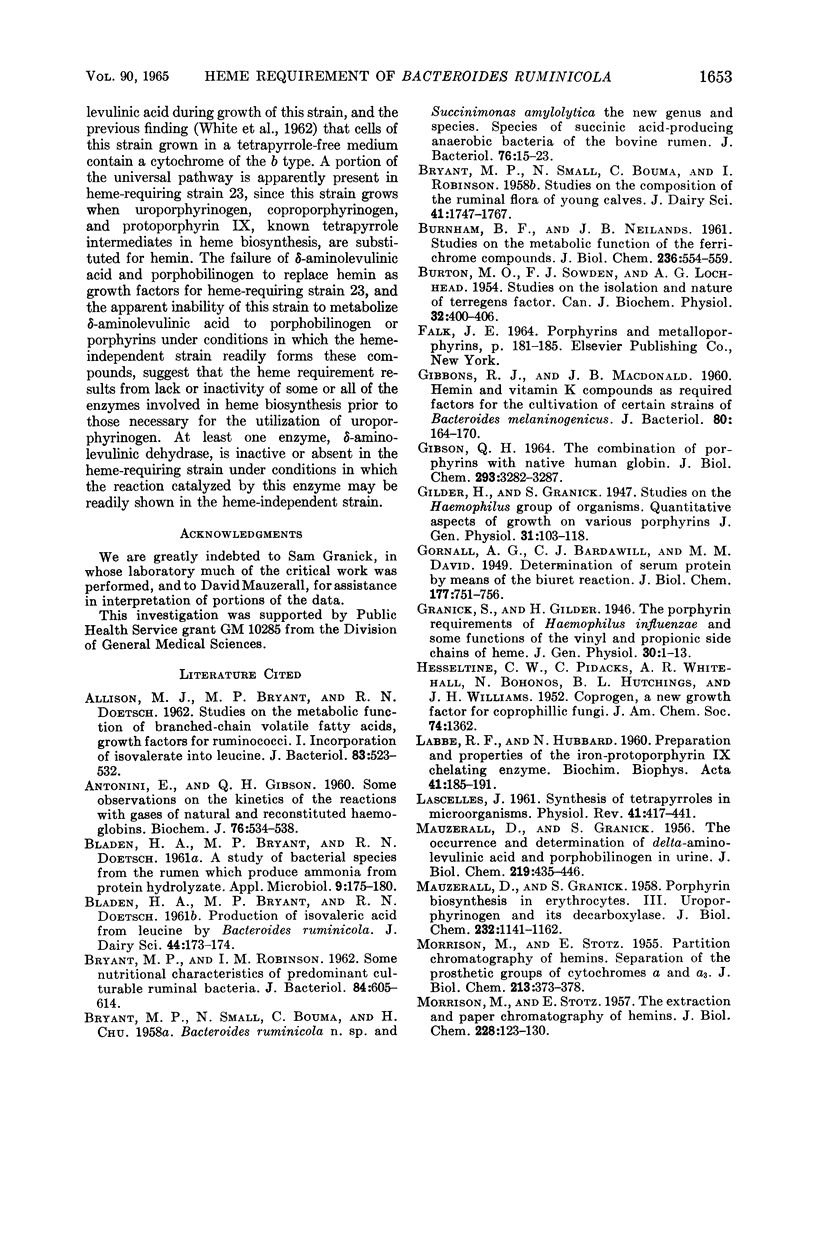
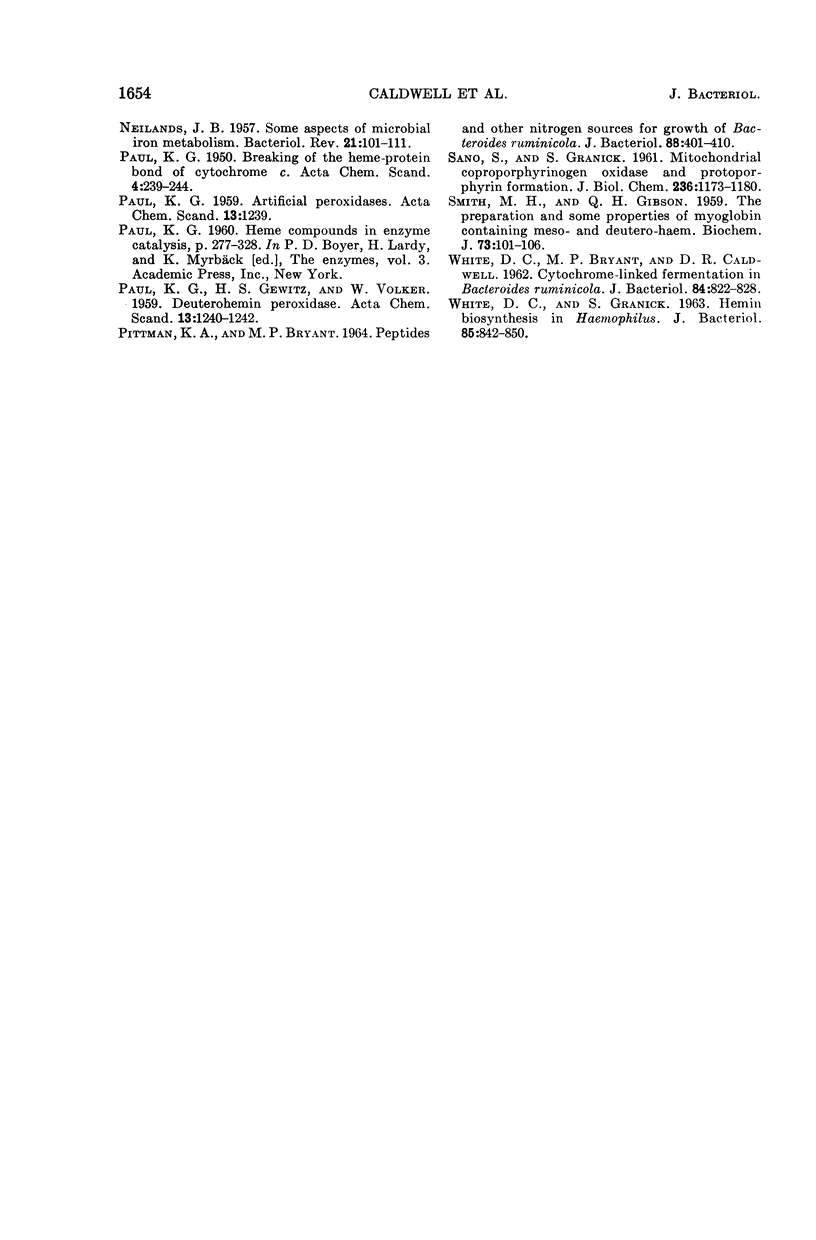
Selected References
These references are in PubMed. This may not be the complete list of references from this article.
- ALLISON M. J., BRYANT M. P., DOETSCH R. N. Studies on the metabolic function of branched-chain volatile fatty acids, growth factors for ruminococci. I. Incorporation of isovalerate into leucine. J Bacteriol. 1962 Mar;83:523–532. doi: 10.1128/jb.83.3.523-532.1962. [DOI] [PMC free article] [PubMed] [Google Scholar]
- ANTONINI E., GIBSON Q. H. Some observations on the kinetics of the reactions with gases of natural and reconstituted haemoglobins. Biochem J. 1960 Sep;76:534–538. doi: 10.1042/bj0760534. [DOI] [PMC free article] [PubMed] [Google Scholar]
- BRYANT M. P., ROBINSON I. M. Some nutritional characteristics of predominant culturable ruminal bacteria. J Bacteriol. 1962 Oct;84:605–614. doi: 10.1128/jb.84.4.605-614.1962. [DOI] [PMC free article] [PubMed] [Google Scholar]
- BRYANT M. P., SMALL N., BOUMA C., CHU H. Bacteroides ruminicola n. sp. and Succinimonas amylolytica; the new genus and species; species of succinic acid-producing anaerobic bacteria of the bovine rumen. J Bacteriol. 1958 Jul;76(1):15–23. doi: 10.1128/jb.76.1.15-23.1958. [DOI] [PMC free article] [PubMed] [Google Scholar]
- BURNHAM B. F., NEILANDS J. B. Studies on the metabolic function of the ferrichrome compounds. J Biol Chem. 1961 Feb;236:554–559. [PubMed] [Google Scholar]
- BURTON M. O., SOWDEN F. J., LOCHHEAD A. G. Studies on the isolation and nature of the terregens factor. Can J Biochem Physiol. 1954 Jul;32(4):400–406. [PubMed] [Google Scholar]
- Bladen H. A., Bryant M. P., Doetsch R. N. A Study of Bacterial Species from the Rumen Which Produce Ammonia from Protein Hydrolyzate. Appl Microbiol. 1961 Mar;9(2):175–180. doi: 10.1128/am.9.2.175-180.1961. [DOI] [PMC free article] [PubMed] [Google Scholar]
- GIBBONS R. J., MACDONALD J. B. Hemin and vitamin K compounds as required factors for the cultivation of certain strains of Bacteroides melaninogenicus. J Bacteriol. 1960 Aug;80:164–170. doi: 10.1128/jb.80.2.164-170.1960. [DOI] [PMC free article] [PubMed] [Google Scholar]
- GIBSON Q. H. THE COMBINATION OF PORPHYRINS WITH NATIVE HUMAN GLOBIN. J Biol Chem. 1964 Oct;239:3282–3287. [PubMed] [Google Scholar]
- LABBE R. F., HUBBARD N. Preparation and properties of the iron-protoporphyrin chelating enzyme. Biochim Biophys Acta. 1960 Jul 1;41:185–191. doi: 10.1016/0006-3002(60)90001-9. [DOI] [PubMed] [Google Scholar]
- LASCELLES J. Synthesis of tetrapyrroles by microorganisms. Physiol Rev. 1961 Apr;41:417–441. doi: 10.1152/physrev.1961.41.2.417. [DOI] [PubMed] [Google Scholar]
- MAUZERALL D., GRANICK S. Porphyrin biosynthesis in erythrocytes. III. Uroporphyrinogen and its decarboxylase. J Biol Chem. 1958 Jun;232(2):1141–1162. [PubMed] [Google Scholar]
- MAUZERALL D., GRANICK S. The occurrence and determination of delta-amino-levulinic acid and porphobilinogen in urine. J Biol Chem. 1956 Mar;219(1):435–446. [PubMed] [Google Scholar]
- MORRISON M., STOTZ E. Partition chromatography of hemins; separation of the prosthetic groups of cytochromes a and a3. J Biol Chem. 1955 Mar;213(1):373–378. [PubMed] [Google Scholar]
- MORRISON M., STOTZ E. The extraction and paper chromatography of hemins. J Biol Chem. 1957 Sep;228(1):123–130. [PubMed] [Google Scholar]
- NEILANDS J. B. Some aspects of microbial iron metabolism. Bacteriol Rev. 1957 Jun;21(2):101–111. doi: 10.1128/br.21.2.101-111.1957. [DOI] [PMC free article] [PubMed] [Google Scholar]
- PITTMAN K. A., BRYANT M. P. PEPTIDES AND OTHER NITROGEN SOURCES FOR GROWTH OF BACTEROIDES RUMINICOLA. J Bacteriol. 1964 Aug;88:401–410. doi: 10.1128/jb.88.2.401-410.1964. [DOI] [PMC free article] [PubMed] [Google Scholar]
- SANO S., GRANICK S. Mitochondrial coproporphyrinogen oxidase and protoporphyrin formation. J Biol Chem. 1961 Apr;236:1173–1180. [PubMed] [Google Scholar]
- SMITH M. H., GIBSON Q. H. The preparation and some properties of myoglobin containing meso- and deutero- haem. Biochem J. 1959 Sep;73:101–106. doi: 10.1042/bj0730101. [DOI] [PMC free article] [PubMed] [Google Scholar]
- WHITE D. C., BRYANT M. P., CALDWELL D. R. Cytochromelinked fermentation in Bacteroides ruminicola. J Bacteriol. 1962 Oct;84:822–828. doi: 10.1128/jb.84.4.822-828.1962. [DOI] [PMC free article] [PubMed] [Google Scholar]
- WHITE D. C., GRANICK S. HEMIN BIOSYNTHESIS IN HAEMOPHILUS. J Bacteriol. 1963 Apr;85:842–850. doi: 10.1128/jb.85.4.842-850.1963. [DOI] [PMC free article] [PubMed] [Google Scholar]


